This section contains entries about our botanizing in Baja California written for the UC BEE (Oct 2012 to Aug 2021)
and The UC Hive (2022-), monthly newsletters for volunteers and staff of the UC Berkeley Botanical Garden.
Click on any photo for a larger image.
THE HIVE JUNE 2025
Sierra de Guadalupé via Arroyo San Nicolás, Mulegé, BCS
 In April, my friend Javier and I took a drive up into theSierra de Guadalupe west of Mulegé to visit Rancho El Sauce (see map). This was my third trip to the ranch and I was hoping to find some mosses and maybe other hydrophytic plants along the spring that arises out of the mountainside and passes through the ranch along a narrow gully.
In April, my friend Javier and I took a drive up into theSierra de Guadalupe west of Mulegé to visit Rancho El Sauce (see map). This was my third trip to the ranch and I was hoping to find some mosses and maybe other hydrophytic plants along the spring that arises out of the mountainside and passes through the ranch along a narrow gully.
On our first trip in 2020, there was quite a bit of water in the stream and in the small dams built into the arroyo below. I only walked a short distance up the gully where I collected a few plants along the water's edge. Later we were shown to a rock outcrop farther downstream, from which we could look down into the deep ravine and several small cascades far below.
The weather on both this and our last trip in May 2024 was very warm (mid to high 90s at the ranch) and the desert was looking increasingly drier. Last year, a lot of the Palo Verde and Mesquites were showing signs of blooming, while many of the shrubby species had some leaves.
However, this time there were very few blooming trees and most of the shrubs were bare. The area is has gone through two summer "rainy" seasons without substantial preciptation and it´s looking like a third is on the way.
The map above shows the route we took up into the mountains from Mulegé via Arroyo San Nicolás. The ranch is approx. 17.5 miles (28 km) from Hwy 1, and there is an elevation gain of 1312 ft (400 meters). More photos of the landscape along this route can be seen in the first section of my July 2020 entry.
For previous Sierra Guadalupe trips, see: Apr 2013 (San José de Magdalena - SJdM); May 2014 (Pacific route to La Ballena); Jun 2015 (SJdM); Jan 2018 (Arroyo las Chuparrosas in southern valley); Jan 2019a and Jan 2019b (Sierra Zacatecas & Sierra Guadalupe via Pacific route); Jul 2020 (Arroyo San Nicolás & SJdM); May 2021 (SJdM to Mulegé via ex-Misión de Guadalupe); and Feb 2024 (Rancho Ingerto, Vado de la Virgencita, the Seep & Rancho El Aguajito).
For a full list of this month's plants and other organisms (with family, latín name and common names in both English and Spanish), visit this page.

A picturesque rocky outcrop on the way up into the sierras via Arroyo San Nicolás.

Here, the road is about to pass under some very old Mesquite trees and past the livestock corrals at one of the remote ranches.
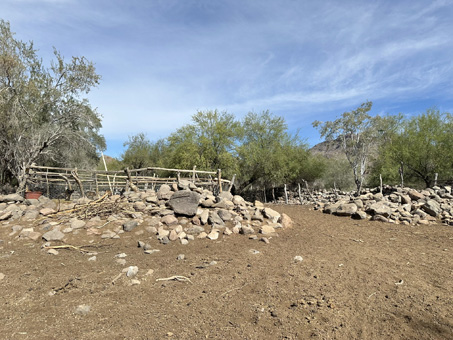
Passing by another ranch along the way. Corrals and other enclosures are commonly constructed with local resources such as volcanic rocks and wood from trees and shrubs.
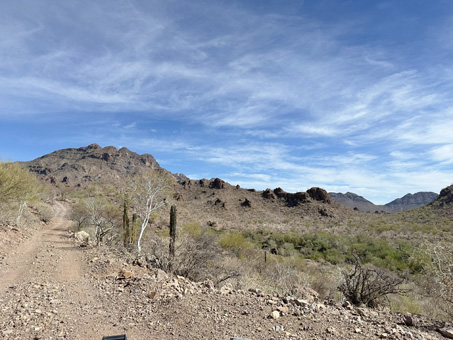
Typical sierra vegetation includes: Palo Blanco (Lysiloma candidum), Cardón (Pachycereus pringlei), Little-leaf Palo Verde (Parkinsonia microphylla) and Little-leaf Elephant Tree (Bursera microphylla).

More examples of the desert plants include: Organpipe Cactus (Stenocereus thurberi var. thurberi) and Chain-link Cholla (Cylindropuntia cholla).

At the top of a crest, not far from our final destination. The hills are variable in the type of volcanic rocks, ranging from dark basalt clinkers (here) to ochre, purple, red or pink andesites and brechias .
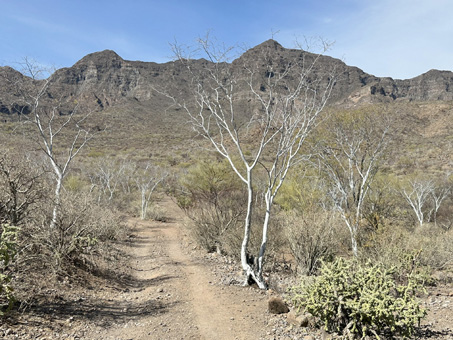
The Palo Blanco (Lysiloma candidum) are abundant in the valleys and on the slopes and cliffs, and were especially notable along this stretch where the road twisted between the slender trunks. They were visible as far as the eye could see.
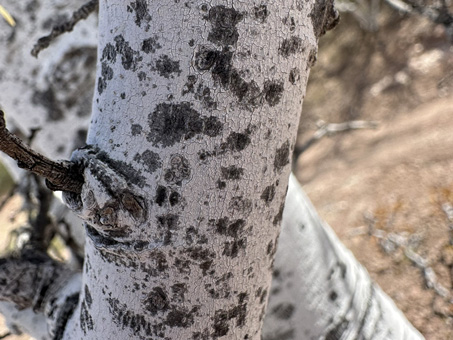
Is this a lichen with a white thallus & black spots on Palo Blanco?. Some spots are most likely part of the bark, which does darken with age. However, some of the black & white substance could be scraped off. Samples for the experts will hopefully reveal the truth.
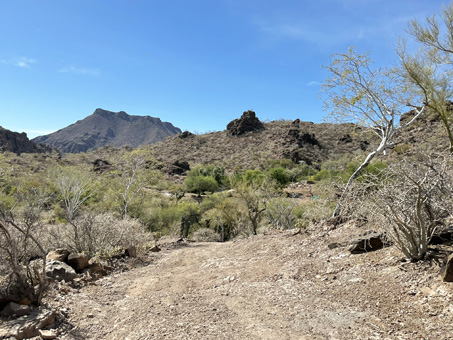
Near the end of the road and our destination for the day. I was looking forward to seeing what I might find along the stream there.
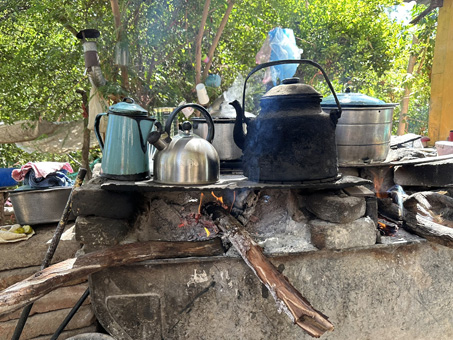
We arrived mid morning and there was a pot of birria (a chile-based beef stew) cooking on the horno (wood-fired stove/oven). Yum!

Some of the residents. Goats are the most adapted to living in the desert mountains, but cattle, sheep (a desert variety) and chickens can also be found.

This curious chicken jumped right up onto the door of the buggy right after we arrived. Not much later, a couple of goats made themselves comfortable in the shade under the vehicle.
After visiting with the ranch family for awhile and partaking of a bit of birria, as well as sharing our lunches and drinks, I set out for the nearby ravine and creek where there was a series of shallow pools below a small cement dam.

About half way up the ravine, looking downstream. There was a small trickle along the gravelly bottom.
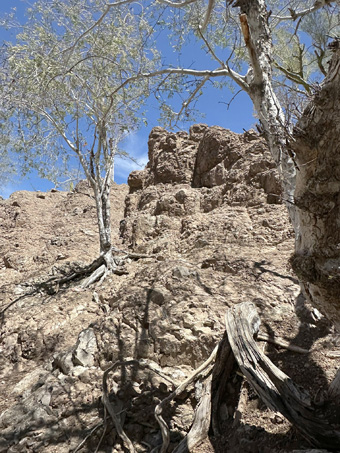
The steep, rocky wall of the ravine mirraculously have trees growing out of them.
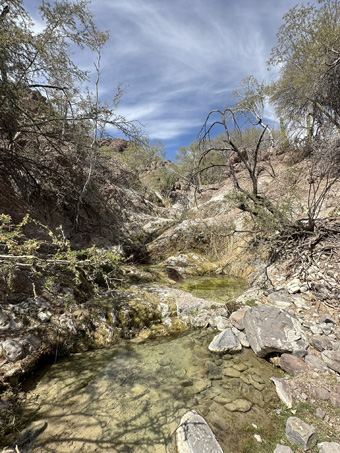
I've turned to look upstream at the series of pools that descend the ravine. Livestock impact the creek bed.
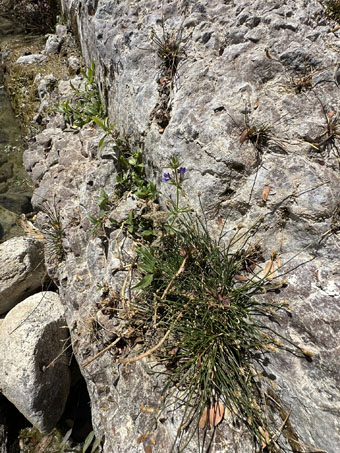
The rock slabs were composed of volcanic conglomerates and plants grew out of fissures in them.
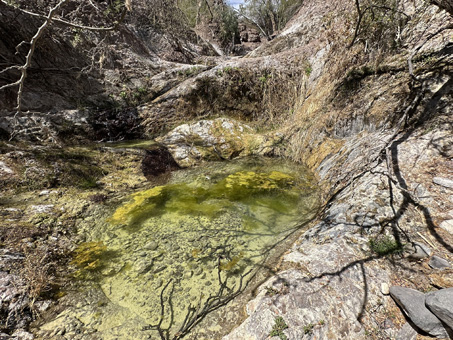
I climbed over a few rocks and up a small slope to get a better look at the pools. A dense yellow-green wooly mat of algae (locally called lana = wool) was floating on the surface.
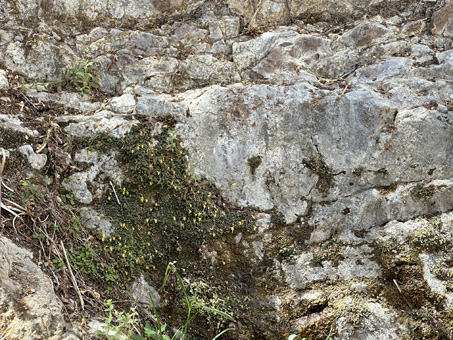
I've reached the farthest I could easily walk. At this point, the rocks pictured, as well as those at my left, were covered with a dense mat of vegetation. The most abundant was Erythranthe dentiloba.
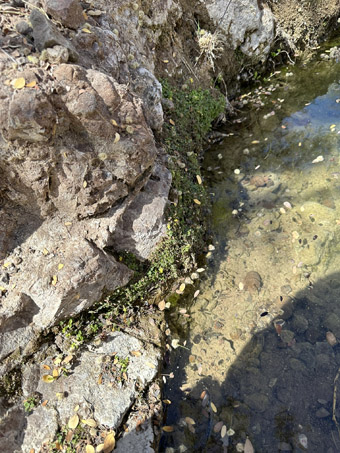
Looking down from the edge of the pool. The Tooth-petal Monkeyflower (Erythranthe dentiloba) formed a fringe from the surface of the pool straight up the rock face.

More of the dense layer of vegetation. There was water seeping down the rock slabs here at the end of the lower part of the creek and it kept all of the hydrophytic species very happy.
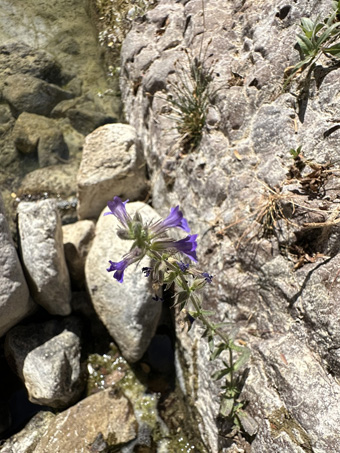
Species included Stemodia durantifolia var. durantifolia, Eleocharis geniculata and E. parishii.
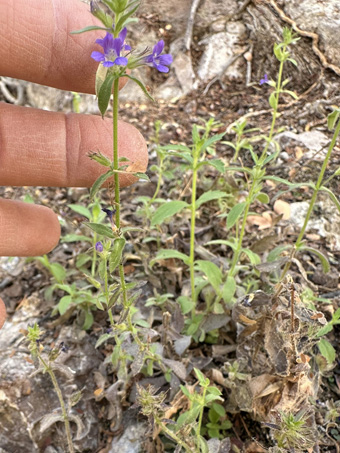
Stemodia durantifolia var. durantifolia was abundant on the rock face and at its base.
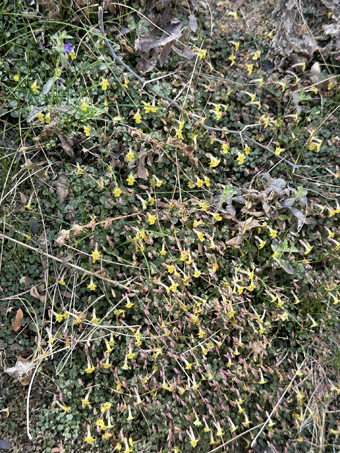
A mat of Erythrante dentiloba, with moss, Eleocharis parishii, Stemodia & Bacopa monnieri, Tubular fls yellow, c. 1.5 mm L; 8-10 mm D limb; the throat & lower fused lobes with with several red spots.
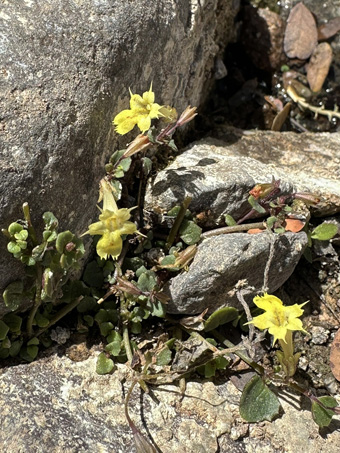
This E. dentiloba plant was in the sun in the creekbed below the pools. The leaves (1+ cm W) were about twice the size as those in the mats. The flowers too were larger, the limb about 15 mm W.
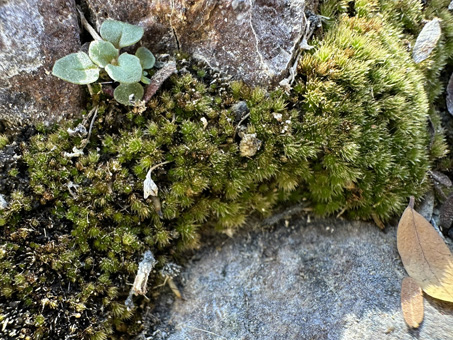
There was abundant patches of moss in the rock crevices and mixed in with the vegetation on the rock faces.

Closeup of the moss. Each cluster is about 4-5 mm D and the pillows had a nice layer of dirt and sand between it and the rock.

California Acacia (Vachellia brandegeeana), a BCS endemic shrub, with a clump of Mistletoe (Phoradendron californica, foreground).
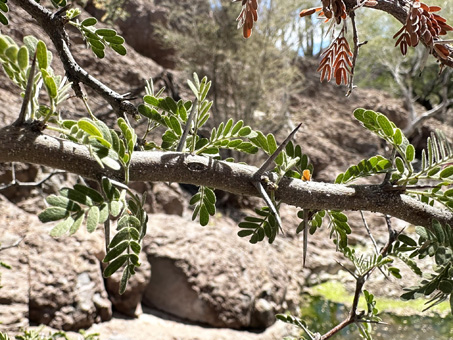
California Acacia is not very common in BCS, but it is quite abundant in the Mulegé valley & mountains. It ranges south to the Cape.
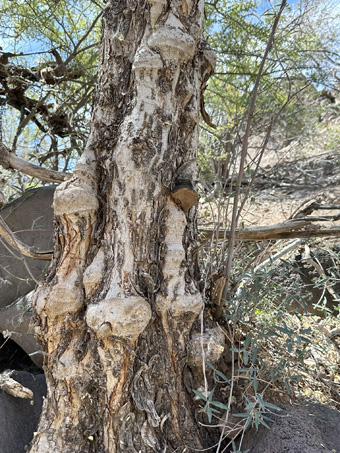
Deformities (fungal?) on the trunk of a Palo Blanco, with a conk (fruiting body of a fungus) about midway up on the right edge.

A closer look at the conk which is 4-5 cm across. The lower surface is smooth. I've seen these conks before, all on Palo Blancos.
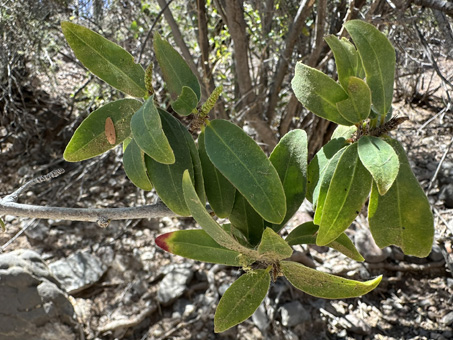
Arrow Poison Plant (Pleradenaphora bilocularis) is a medium to large shrub with a toxic milky sap. It is common in the BCS sierras.

The staminate inflorescence of Pleradenaphora bilocularis is c. 2 cm L. Its 3-lobed capsule is better known as a Mexican Jumping Bean.
That's it for this month. I had to change my plans for the trip north and so unfortunately wasn't able to do any exploration on the way home. Stay tuned for more adventures later this year. Until then, hasta pronto...see you soon.
Debra Valov — Curatorial Volunteer
For a full inventory list of this month's plants (family, latin name and common names in both English and Spanish as well as links to photos from previous posts or my iNaturalist observations), visit this page.
References and Literature Cited
Rebman, J. P., J. Gibson, and K. Rich, (2016). Annotated checklist of the vascular plants of Baja California, Mexico. Proceedings of the San Diego Society of Natural History, No. 45, 15 November 2016. San Diego Natural History Museum, San Diego, CA. Full text available online.
Rebman, J. P and Roberts, N. C. (2012). Baja California Plant Field Guide. San Diego, CA: Sunbelt Publications. Descriptions and distribution.
Valov, D. (2020). An Annotated Checklist of the Vascular Plants of Mulegé, Baja California, Mexico. Madroño 67(3), 115-160, (23 December 2020). https://doi.org/10.3120/0024-9637-67.3.115
Wiggins, I. L. (1980). The Flora of Baja California. Stanford University Press. Keys and descriptions.


































